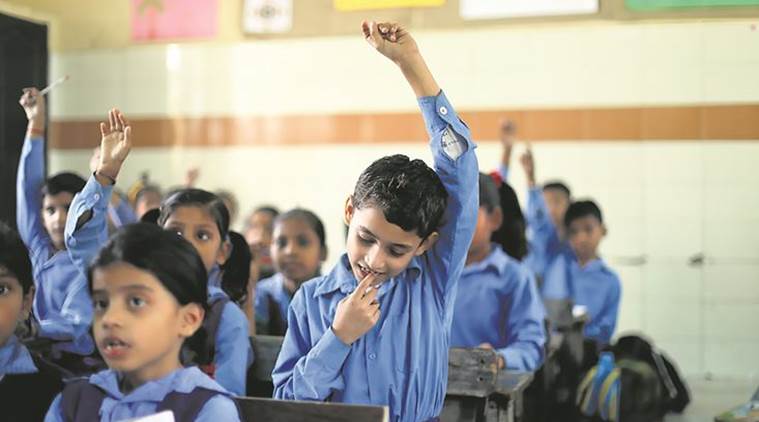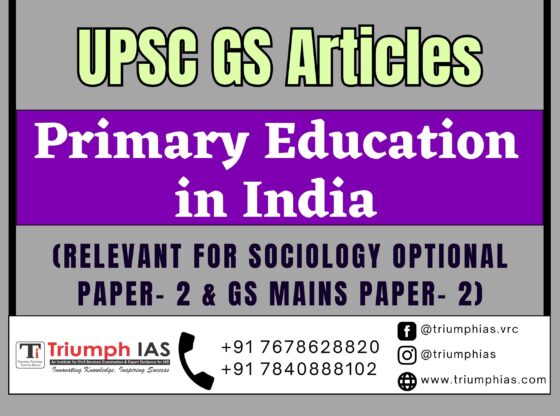Primary Education in India
Relevant for sociology optional Paper- 2 & GS Mains Paper- 2

India has a population of over 1.3 billion, making it the second-most populous country in the world. With such a large population, education has become an essential aspect of the country’s development. Primary education is the foundation of every child’s academic journey, and it plays a crucial role in shaping their future. In India, the primary education system is governed by both the central and state governments, and it is one of the largest education systems in the world.
The primary education system in India is structured into two levels: primary education, which covers classes 1 to 5, and upper primary education, which covers classes 6 to 8. The education system is designed to provide free education to all children between the ages of 6 and 14 years. The government has implemented several policies and schemes to ensure that all children have access to quality education.
One of the main challenges faced by the primary education system in India is ensuring that all children have access to education. According to a report by UNESCO, India has the highest number of out-of-school children in the world. Poverty, social and cultural norms, and the lack of proper infrastructure are some of the reasons why children do not attend school. To address this issue, the government has implemented several schemes, such as the Sarva Shiksha Abhiyan (SSA) and the Right to Education (RTE) Act.
The SSA was launched in 2001 with the objective of providing universal access to primary education. The scheme focuses on improving the quality of education and increasing the enrolment of children in schools. It provides funds to the states to build schools, recruit teachers, and provide free textbooks and uniforms to students. The SSA has been successful in increasing the enrolment of children in schools, and it has also improved the quality of education in rural areas.
The RTE Act was implemented in 2009, which made education a fundamental right for every child between the ages of 6 and 14 years. The act provides for free and compulsory education to all children, and it also prohibits the practice of holding back children in the same grade or expelling them from school. The act has been instrumental in increasing the enrolment of children in schools, especially in rural areas.
Despite these schemes, the primary education system in India still faces several challenges. The quality of education in government schools is often poor, and there is a shortage of trained teachers. Many children drop out of school due to poverty, and the lack of proper infrastructure in schools also hampers the learning process. Additionally, the education system in India is often criticized for being too focused on rote learning and not enough on critical thinking and problem-solving skills.
To address these challenges, the government has implemented several initiatives to improve the quality of education. The National Curriculum Framework (NCF) was introduced in 2005, which provides a framework for the development of a national curriculum. The framework emphasizes the need for child-centred education and encourages the development of critical thinking skills.
The government has also launched the Rashtriya Madhyamik Shiksha Abhiyan (RMSA) to improve the quality of education in upper primary schools. The scheme focuses on providing infrastructure and training to teachers to improve the quality of education. The government has also launched the Mid-Day Meal Scheme, which provides free meals to children in government schools. The scheme has been successful in increasing the enrolment of children in schools, especially in rural areas.
In addition to these initiatives, the government has also encouraged the use of technology in education. The Digital India campaign was launched in 2015, which aims to provide digital infrastructure and services to all citizens. The government has also launched the ePathshala initiative, which provides free e-books and digital resources to students. The ePathshala initiative has been successful in providing access to digital resources to students in remote areas, and it has also reduced the burden of carrying heavy textbooks. The government has also launched the SWAYAM platform, which provides online courses to students and teachers. The platform has been instrumental in providing access to higher education to students who cannot afford to attend traditional colleges and universities.
In conclusion, primary education in India plays a crucial role in shaping the future of the country. The government has implemented several policies and schemes to ensure that all children have access to quality education. However, there are still challenges that need to be addressed, such as improving the quality of education, increasing the enrolment of children in schools, and addressing the issue of out-of-school children. The government’s initiatives to improve the quality of education through the use of technology, such as the Digital India campaign, ePathshala, and SWAYAM, have been successful in providing access to education to students in remote areas and reducing the burden of carrying heavy textbooks. With the continued efforts of the government and the cooperation of all stakeholders, India’s primary education system can continue to improve and provide quality education to all children.
For more such free UPSC notes, Articles, News & Views Join our Telegram Channel. https://t.me/triumphias
Click the link below to see the details about the UPSC – Civils courses offered by Triumph IAS. https://triumphias.com/pages-all-courses.php


